最新-学年高中英语-Unit-2-Sailing-the-oceans-Sailing-the-oceans教案-新人教版选修9资料
- 格式:doc
- 大小:196.50 KB
- 文档页数:9
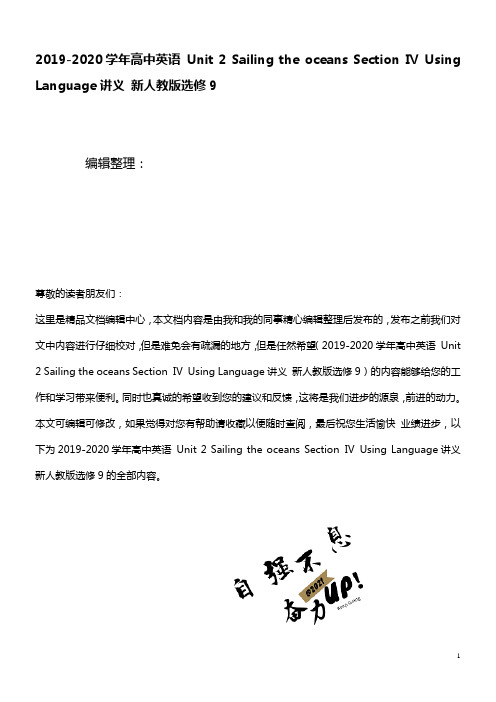
2019-2020学年高中英语Unit 2 Sailing the oceans Section ⅣUsing Language讲义新人教版选修9编辑整理:尊敬的读者朋友们:这里是精品文档编辑中心,本文档内容是由我和我的同事精心编辑整理后发布的,发布之前我们对文中内容进行仔细校对,但是难免会有疏漏的地方,但是任然希望(2019-2020学年高中英语Unit 2 Sailing the oceans Section ⅣUsing Language讲义新人教版选修9)的内容能够给您的工作和学习带来便利。
同时也真诚的希望收到您的建议和反馈,这将是我们进步的源泉,前进的动力。
本文可编辑可修改,如果觉得对您有帮助请收藏以便随时查阅,最后祝您生活愉快业绩进步,以下为2019-2020学年高中英语Unit 2 Sailing the oceans Section ⅣUsing Language讲义新人教版选修9的全部内容。
Section ⅣUsing LanguageⅠ.阅读P17-18课文内容,从三个选项中选择最佳答案1.Why didn’t Captain Bligh finish the voyage with them?A.Because he wasn’t skillful enough。
B.Because he was deposited into a small boat.C.Because he was seriously ill.2.They can’t get a correct reading f rom the quadrant as .A.the quadrant was brokenB.the boat moved so quicklyC.the boat moved constantly3.What was the hardest to cope with for them?A.The bad weather。
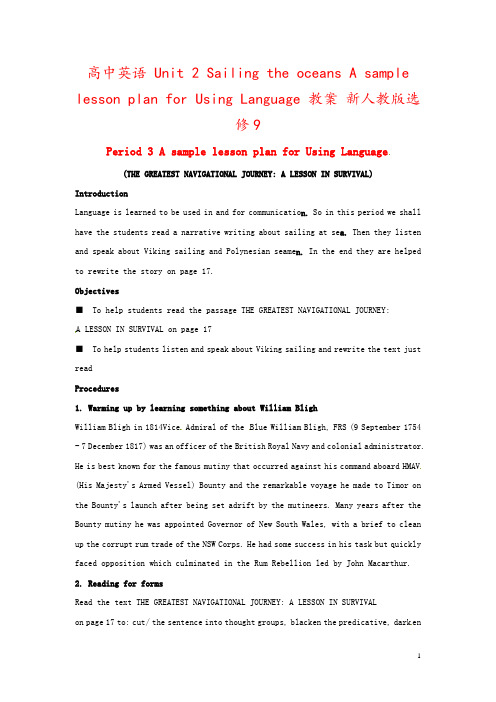
高中英语 Unit 2 Sailing the oceans A sample lesson plan for Using Language 教案新人教版选修9Period 3 A sample lesson plan for Using Language(THE GREATEST NAVIGATIONAL JOURNEY: A LESSON IN SURVIVAL)IntroductionLanguage is learned to be used in and for communicatio n.So in this period we shall have the students read a narrative writing about sailing at se a. Then they listen and speak about Viking sailing and Polynesian seame n. In the end they are helped to rewrite the story on page 17.Objectives■To help students read the passage THE GREATEST NAVIGATIONAL JOURNEY:A LESSON IN SURVIVAL on page 17■To help students listen and speak about Viking sailing and rewrite the text just readProcedures1. Warming up by learning something about William BlighWilliam Bligh in 1814Vice Admiral of the Blue William Bligh, FRS (9 September 1754 - 7 December 1817) was an officer of the British Royal Navy and colonial administrator. He is best known for the famous mutiny that occurred against his command aboard HMAV (His Majesty's Armed Vessel) Bounty and the remarkable voyage he made to Timor on the Bounty's launch after being set adrift by the mutineers. Many years after the Bounty mutiny he was appointed Governor of New South Wales, with a brief to clean up the corrupt rum trade of the NSW Corps. He had some success in his task but quickly faced opposition which culminated in the Rum Rebellion led by John Macarthur. 2. Reading for formsRead the text THE GREATEST NAVIGATIONAL JOURNEY: A LESSON IN SURVIVALon page 17 to: cut/ the sentence into thought groups, blacken the predicative, dark enthe connectives and underline all the useful expressions.3. Copying expressions and making sentencescatch in a dilemma, risk certain death, sit close together,face an uncertain future, have no charts, take with sb., set the course, make sure, stay on that course, keep to a straight course, in addition, keep sb. work out the position, take a great deal of time, cope with, drive sb. mad, preserve one’s good spirits, talk hopefully about, g et worse, sink into…, take one’s minds off one’s stomachs and thirst, keep sb. alive, set loose, have fever, show the hardships, suffer the hardships, escape the jaws of death, complete the greatest navigational feat of all time4. Listening and speaking about Viking sailing and Polynesian seamen●The name Viking is a borrowed word from the native Scandinavian term for the Norse warriors who raided the coasts of Scandinavia, the Bri tish Isles, and other parts of Europe from the late 8th century to the 11th century. Vikings traveled to the west and Varangians, who were best known as the Varangian Guards of the Byzantine emperors, to the east. This period of European history (generally dated to 793 - 1066 AD) is referred to as the Viking Age.●Where is Polynesia?A division of Oceania including scattered islands of the central and southern Pacific Ocean roughly between New Zealand, Hawaii, and Easter Island. The larger islands are volcanic, the smaller ones generally coral formations.Now go to page 19. Let’s go to listen to something about Viking sailing the oceans. While listening try to circle those aids in the box on page 19 that the early sailors used to find their ways at se a.Now you shall listen to the tape once a gain to fill in the chart on page 19.On page 20 there are four sayings from Polynesian seame n.What does each of them mean? Now in pairs talk about each of the sayings.5. Closing down by writing, by imitation, a passage of your own based on the text on page 17A possible versionI am proud to have traveled with my father on his journey of over 60 days through about 4,000 kilometers in an open car across China in 2006. Our outward journey in the car to Hainan had been filled with the kind of incidents that I thought would be my stories when I returned home.But how wrong I was! On our departure from Taiyuan,some of the bad men took over the car. They deposited my father onto a small bike to 1et us find our own way home.But what else was to be done? We on the road were caught in a dilemma.Once we were far away from the bad men,our routine the following three days was the same.At sunrise and sunset my father measured our position listening to the local new on the radio and set the course /using the signs along the road.It was extremely diff icult for us to get a correct direct ion from the radio as the bike moved constantly.I used a system called “people reckoning”.I knew there were villages directly northwest of our original positio n. So my task was to make sure we discover any of the villages. As you can see now from the map we kept to a str aight course pretty well. In addition, my father kept me busy singing songs to overcome our tiredness. Although this took a great deal of strength, it didn’t matter. Songs were, after all, what I had a lot of!You could not imagi ne a more disturbing sight than what we looked like when arriving in Yaojiagou over three days after being robbed of our open car.Our clothes were torn,we had fever and our faces showed the hardships we had suffered.But after a rest,some good meals and some new clothes,everything changed.We couldn’t stop talking about our journey and everybody wanted to hear about it.We were the heroes who had escaped the jaws of death by completing the greatest traveling feat of all time!。
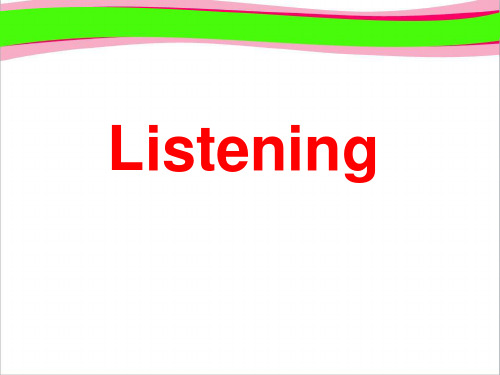
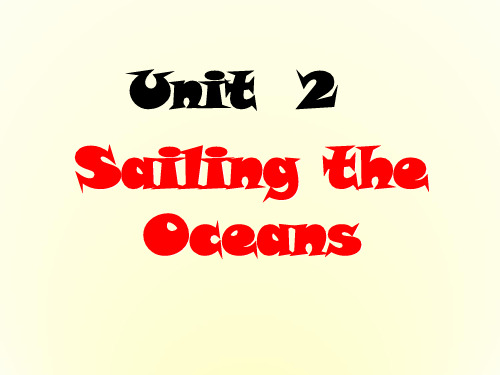
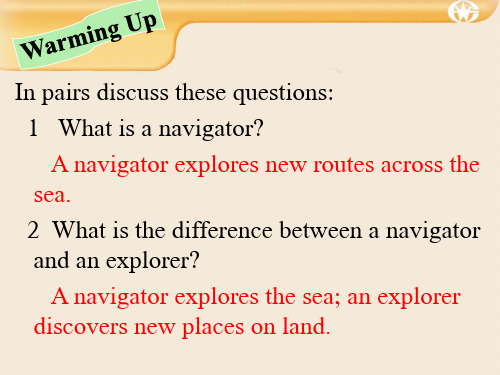
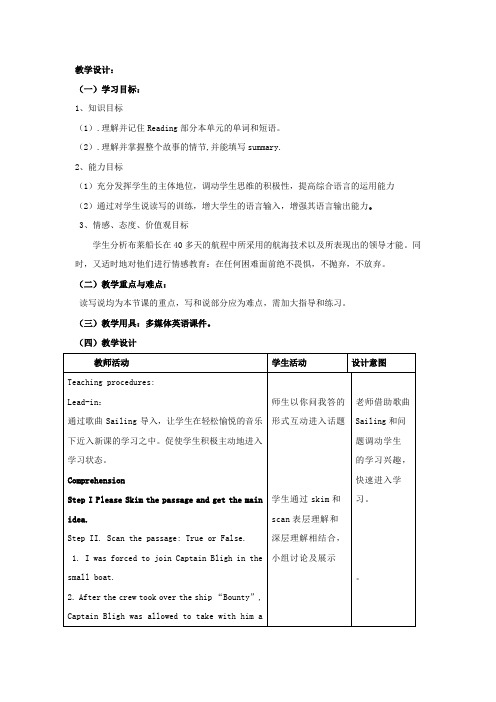
教学设计:(一)学习目标:1、知识目标(1).理解并记住Reading部分本单元的单词和短语。
(2).理解并掌握整个故事的情节,并能填写summary.2、能力目标(1)充分发挥学生的主体地位,调动学生思维的积极性,提高综合语言的运用能力(2)通过对学生说读写的训练,增大学生的语言输入,增强其语言输出能力。
3、情感、态度、价值观目标学生分析布莱船长在40多天的航程中所采用的航海技术以及所表现出的领导才能。
同时,又适时地对他们进行情感教育:在任何困难面前绝不畏惧,不抛弃,不放弃。
(二)教学重点与难点:读写说均为本节课的重点,写和说部分应为难点,需加大指导和练习。
(三)教学用具:多媒体英语课件。
(四)教学设计1.探究早期海洋冒险家的经历,使学生对成为航海家所应该具备的素质有一定的了解。
同时,让学生明确船长在航海中所起的重大作用,并讨论船长布莱在航行中所具备领导素质的具体体现。
2.在教学中,我发现学生在学习时,对其概念、理论、方法等,并不是无动于衷,而是常常抱有各种不同的态度,会有各种复杂的内心体验。
如果顺利完成学习任务,会感到满意、愉快和欢乐;学习失败时,则会感到痛苦、恐惧和憎恨;遇到新奇的问题、结论和方法时,会产生惊讶和欣慰。
虽然这种情感不直接参与教学的认知活动,但对知识学习起着推动、增加、坚持、调节等作用。
因此,利用这篇课文适时地对学生进行:在困难和挫折面前,不放弃、不抛弃的精神。
3.学生不只想把英语作为一门死记硬背的课程来学,更希望能学到知识性和趣味性兼有的内容,从英语学习中获得更多的知识和能力。
1、这节课使学生的综合能力得到了训练。
在认知能力方面,快速阅读理解训练促使学生的观察力、注意力、记忆力高度集中;深层阅读理解训练使学生思维能力、想象力得到发展。
在语言能力方面,各个阶段中阅读理解问题的解决使学生的听说、读写能力得到全面培养,尤其是阅读理解能力更得到了充分发展。
在交往能力方面,同学们在老师引导下,在交流与讨论中相互合作、相互沟通,最后得出认识比较统一的答案。
英语:Unit2《Sailing the oceans》教案(1)(新人教版选修9)分课时教案The First Period SpeakingTeaching Aims:a. Key words and expressionsnavigate, navigator, navigation, navigational; explore, explorer, exploration b. Talk about sailing the oceans.Teaching Methods:Discussion to arouse the students’ interest in sailing and exploring the oceans. Individual, pair or group work to make every student work in class.Teaching Aids:The multimedia; a tape recorder; the blackboardTeaching Procedures:Step1 GreetingsGreet the whole class as usual.Step2 RevisionCheck the homework exercises.Step 3 PresentationPresent the students a map of the world and tell them “Today we are going to learn a new unit “Sailing the oceans”. Then ask them to turn to page 11 and give them a few minutes to have a discussion.Step 4 DiscussionIn pairs discuss the questions on page11.This discussion is intended for students to explore the difference between a navigator and an explorer. This difference is important to establish because it encourages students to appreciate shades of meaning in the definitions f words and also because it establishes the idea of categories.After a few minutes, ask some pairs to speak out their result of the discussion. Then sum up and check the answers.A navigator explores new routes across the sea.An explorer discovers new places on land.A navigator is somebody who finds the position and plots the course of a ship, an aircraft, a car, etc, using maps and instruments. An explorer is somebody who travels into or through a place in order to learn about it. Very often navigators are also explorers.In history there are four famous voyage explorers in the world, including Zheng He in China, James Cook in England, Christopher Columbus in Spain and Abel Tasman in Holland.In this unit we’ll talk about Zheng He, James Cook and some other explorers like Marco Polo and Captain Bligh.Step 5 Pre-speakingAsk the students if they want to know some famous navigators and explorers. Then present them some pictures and some related information about them.About Zheng He.About Marco PoloAbout James CookAbout Ferdinand MagellanStep 6 SpeakingAfter showing the students the pictures and their background information, ask the students to think about the question: How do you think seamen found their way before modern accurate methods of navigation were invented? If time is limited, this can be left as their homework.Step 7 Homework1. Read the new words.2. Preview Reading SAILING THE OCEANS on page 12.The Second Period ReadingTeaching Aims:a. Learn and master the key words and expressionsvoyage mercy minimum nowhere pole overhead offshore accelerate outward longitude latitude precise simplify portable shortcoming updated tendency reliableat the mercy of, even though, work out, be used to, in relation to, aim to , …b. Train the students’ reading ability. Let the students have some knowledge of early navigational methods. Explain how seamen explored the oceans and what kind of navigational instruments were used to sailors before the 17th century when they were navigating the open seas without seeing the land.Teaching Difficult Points:How to help the students understand the reading passage better.How to im prove the students’ reading ability.Teaching Methods:Scanning the text to get the general idea of it.Carefully reading to finish the Comprehending exercises on page 14.Discussion after reading to make the students understand the text better. Teaching Aids:The multimedia; a tape recorder; the blackboardTeaching procedures & waysStep1 GreetingsGreet the whole class as usual.Step2 RevisionCheck the homework exercises.Step3 Pre-readingShow the students some pictures to see if they can identify the early navigational instruments seamen used and explain how they used.Step 4 DiscussionDiscuss the questions on page11.Step 5 Listening and comprehendingAfter listening to the contents of the text do the comprehending exercises on page 14&15.Step 6 ExplanationAfter comprehending, it is a good time to deal with the new words and language points in this part, esp. the following:voyage mercy minimum nowhere pole overhead offshore accelerate outward longitude latitude precise simplify portable shortcoming updated tendency reliableat the mercy of, even though, work out, be used to, in relation to, aim to , Step7 DiscussionLet’s the students have a discussion by working in pairs or in groups.Topic: Imagine you are on a boat with twenty-nine other people. You have a small box for your personal things but it can only hole ten items. What would you need for a week’s journey across the North Sea to England?Step8 SummaryThis reading explains how seamen explored the oceans and what kind of navigational instruments were used to sailors before the seventeenth century when they were navigating the open seas without seeing the land.Step9 HomeworkFinish the exercises about using words and expression on page61.The Third Period Extensive ReadingTeaching Aims:a. Learn and master the key words and expressionsincident departure crew deposit dilemma drawback dusk routine pretty starvation extreme psychologically tension gradually foresee thirst hardshipb. Train the students’ reading ability.Teaching Difficult Points:a. How to help the students understand the reading passage better.b. How to improve the students’ reading ability.Teaching Methods:Scanning the text to get the general idea of it and do some other comprehending exercises.Discussion after reading to make the students understand the text better. Teaching Aids:The multimedia; a tape recorder; the blackboardTeaching procedures & waysStep1 GreetingsGreet the whole class as usual.Step2 RevisionCheck the homework exercises.Suggested answers to Exercise3:I have gradually accepted the routine at school now that I am in the advanced class and make my own study plan.The drawback of using that girl for the advertising was her square jaw which made her look unfriendly.Mathematics is a subject which demands precise and accurate work.In the park I saw a small boy holding the string of a kite overhead, which was rising and falling at the mercy of the wind.That explorer wanted to secure his place in history by being the first man to reach the South Pole.Step3 Readinga. Listen to the passage and then let them do some true or false questions according to the text.1. I was forced to join Captain Bligh in the small boat.2. After the crew took over the ship “Boundy”, Captain Bligh was allowed to take with him a chart , a compass and a quadrant.3. It was very difficult for us to get a correct reading from the quadrant as the boat moved constantly during the course.4. Captain Bligh used a system called “dead reckoning” and he knew there was land directly southwest of their original position.5. We completely believed Captain Bligh when he talked hopefully about what we would do when we got back to England.6. Captain Bligh was as weak as the rest of us but he was determined not to give up.7. Captain Bligh kept us busy and tried to take our minds off our stomach and thirst all the way.8. We finally escaped the jaws of death and arrived in Timor over fifty days after being set loose in our small boat.Answers: (FFTFFTTF)b. Give the students a few minutes to read the passage again and then get the general idea of the text.This is the storey of Captain Bligh’s amazing journey across the Pacific Ocean in an open boat with his followers after another group of sailors under Fletcher Christian had taken over the ship. Later Captain Bligh and his men made for the island of Timor using a combination of navigational skill and “dead reckoning”, which is guessing the correct direction. The voyage lasted over 40 days and was one of the greatest examples of survival at sea.c. Explain some difficult sentences, phrases and words.Key phrases:1. in addition 另外There was an earthquake and, in addition, there were tsunamis.除了地震之外,还有海啸。
人教版高中英语选修9《Unit2Sailingtheoceans》教案人教版高中英语选修9《Unit 2 Sailing the oceans》教案教学准备教学目标1、知识目标(1).理解并记住Reading部分本单元的单词和短语。
(2).理解并掌握整个故事的情节,并能填写summary.2、能力目标(1)充分发挥学生的主体地位,调动学生思维的积极性,提高综合语言的运用能力(2)通过对学生说读写的训练,增大学生的语言输入,增强其语言输出能力。
3、情感、态度、价值观目标学生分析布莱船长在40多天的航程中所采用的航海技术以及所表现出的领导才能。
同时,又适时地对他们进行情感教育:在任何困难面前绝不畏惧,不抛弃,不放弃。
教学重难点教学重点与难点:读写说均为本节课的重点,写和说部分应为难点,需加大指导和练习。
教学过程Teaching procedures:Lead-in:通过歌曲Sailing导入,让学生在轻松愉悦的音乐下近入新课的学习之中。
促使学生积极主动地进入学习状态。
ComprehensionStep I Please Skim the passage and get the main idea.Step II. Scan the passage: True or False.1. I was forced to join Captain Bligh in the small boat.2. After the crew took over the ship “Bounty”, Captain Bligh was allowed to take with him a chart , a compass and a quadrant.3. It was very difficult for us to get a correct reading from the quadrant as the boat moved constantly during the course.4. Captain Bligh used a system called “dead reckoning” and he knew there was land directly southwest of their original position.5. Captain Bligh was as weak as the rest of us but he was determined not to give up.6. Captain Bligh kept us busy and tried to take our minds off our stomachs and thirst all the way.7. We finally escaped the jaws of death and arrived in Timor over fifty days after being set loose in our small boat.Step III. Group work: further reading.When captain Blight returned home he was honored as a hero. Discuss in groups whether he should receive a special medal or not.Step IV. Affective educationAfter learning the text, as senior three students, what can we learn from Captain Blight in our life?Step V. Summary:I am _____ to have sailed with Captain Bligh on his journey of over40 days through about4,000 miles in an open boat ______the Pacific Ocean in 1789.In the beginning, on our ________(depart), some of the crew took _____theship and the captain ___________(deposit) into a small boat. Thus we werecaught _____a dilemma. We decided to stick with him _______thick and thin though we seemed to face _____uncertaindeath.During the long and toughjourney, we encountered manyunexpected hardships. Despite _____(lack) of foodand water, he kept us _______(occupy) and cheerful to take our minds ____troubles. All the way he taught us how to cope _______various situations. Finallythey arrived at Timor __________(success) andthey were honored as _______(hero).The story shows that one man’sspirit and his determination should not ________ (defeat) by circumstances.Complexsentences(分析并翻译1-2个长难句)Challengeyourself!---Grammar Filling1. I’m proud to have sailed withCaptain Blight ____his journey of over 40 days _________about 4,000miles ____anopen small boat _______ the Pacific Ocean.2. On our _________(depart) from T ahiti, some crew took _____the ship. And those of us onboard ____________(catch) in a dilemma.3. As you can see from the map we kept_____a straight course pretty well.4. The captain kept us busy________ (read) the tables to work out our position .5. It was the extreme lack of waterthat was hard to cope with ______________ (psychology)6.He kept us busy and tried to take our minds课后习题Challenge yourself!---Grammar Filling1. I’m proud to have sailed with Captain Blight ____his journey of over 40 days _________about 4,000miles ____an open small boat _______ the Pacific Ocean.2. On our _________(depart) from T ahiti, some crew took _____the ship. And those of us on board ____________(catch) in a dilemma.3. As you can see from the map we kept _____a straight course pretty well.4. The captain kept us busy________ (read) the tables to work out our position .5. It was the extreme lack of water that was hard to cope with ______________ (psychology)6.He kept us busy and tried to take our minds _____our __________(stomach).。
高中英语Unit2SailingtheoceansSectionⅠReading讲义新人教版选修9101236Unit 2 Sailing the oceans当今航海技术达到前所未有的水平,那么你知道古代一些有关航海方面的仪器吗?It was invented by Zhang Heng in the Han Dynasty.It is madeup of a bronze foundation (青铜底盘) and magnetic spoon(磁勺)which is made of natural magnet,positioned right in the centerof the foundation.The handle of the spoon points to the south,while the other side points to the north.When the Sinan is in the still,the handle of the spoon points to the south because of the influence of the terrestrial magnetism (地磁).AstrolabeIt has 17 stars listed as well as a map of the sky overhead(for 37 degrees) and the ecliptic (黄道).The time of day or nightis on the outside edge with noon at the top of the Astrolabe andmidnight at the bottom.It comes with a carrying chain,a pouch,and a book on its use.The reverse side has a sight for measuringthe elevations of the heavenly bodies.SextantThe sextant is a navigational instrument for measuring theangle between the horizon and some object in the sky.First a sailorlooks at the horizon through an eyepiece.At the see light fromthe sun or a star reflected off a small mirror on top of theinstrument,onto a second mirror and into the eyepiece.The navigator can then see two images,the horizon and the sun side by side.He can then measure the angle between them on a scale at the bottom of the instrument.The scale goes from 0 to 120 degrees.An earlier instrument,called a quadrant,measured in angle in the same way but it could only measure angles from 0 to 90 degrees.Nautical chartNautical charts are maps of the depth of the sea and thecurrents of the oceans.They provide modern sailors with routesthrough the seas,rather like roads through the countryside.Theinformation began to be collected in the nineteenth century andhas continued to be updated ever since.These charts were not available to Captain Bligh or Zheng He.两个诱思问题1.What is the theory of the Sinan invented by Zhang Heng?2.Why were the Nautical charts not able to be used by Captain Bligh or Zheng He?【答案】1.The influence of the terrestrial magnetism.2.Because the information began to be collected in the nineteenth century.Section ⅠReading (Warming Up, Prereading,Reading & Comprehending)Ⅰ.根据词性及英文释义写出单词的正确形式1.n.kindness;forgiveness2.n.activity of exploring3.adj.above one's head4.adj.at sea not far from land5.adj.made or done without any plan6.adj.difficult to use7.n.act of mentioning;act of looking at for information8.adj.light and that can be(easily) carried or moved【答案】 1.mercy 2.exploration 3.overhead4.offshore5.random6.awkward7.reference8.portableⅡ.短语填空may well;at the mercy of;work out;be close to;the number of;compare with;in relation to;rather than1.I prefer to walk there take a bus.2.The boat was the rapid river.3.This novel become a classic.4. those who are suffering,we are better off.5.I believe that you can this problem by yourself.【答案】 1.rather than 2.at the mercy of3.may wellpared with5.work outⅠ.阅读P12-13课文内容,从三个选项中选择最佳答案1.How many traditional methods used by seamen are mentioned in the passage?A.Four. B.Five. C.Eight.2.The passage doesn't tell us whether skilledseamen used to use the to judge his position at sea.A.North Star B.sun C.moon3.By studying the winds,seamen could .A.judge the direction of the shipB.know how far away they were from their homeC.tell the distance they had discovered4.From the passage we can learn that .A.why early seamen wanted to sail the seven seasB.there is useful information in an encyclopediaC.early sailors went exploring the seas using their skills and simple instruments5.The purpose of the passage is to tell us .A.keeping a longitude of the coastline is the first and most useful form of explorationB.about the skills and navigational aids early seamen used while sailing the oceansC.the finding of latitude and longitude is a must to plot a ship's position on a map【答案】 1.A 2.C 3.A 4.C 5.BⅡ.阅读P12-13课文内容,完成下列表格6.identify7.direct8.calculating 9.the sun's position 10.starsⅢ.阅读P12-13课文内容,完成下面课文缩写This reading explains how seamen 1. (explore)the oceans and what kind of navigational instruments were used to sailors 2.the seventeenth century 3. they were navigating the open seas without seeing land.The 4. (voyage) of travellers before the 17th century show that they were not 5. the mercy of the sea even though they did not have modern 6. (navigation) aids.The seamen could use celestial bodies, wildlife, the weather or the sea to keep 7. the coastline.They could also use 8.compass to help find the direction that the ship needs to go.They could use the 9. (bear) circle to measure the sun's position and tell if they were sailing on their correct rather than a random course. While the astrolabe,the quadrant and the sextant could help give the seamen the local time and allowed them 10. (find)their latitude at sea.【答案】 1.explored 2.before 3.when 4.voyages 5.at 6.navigational 7.alongside 8.the9.bearing 10.to find。
2019-2020学年高中英语 Unit 2 Sailing the oceans Sailing the
oceans教案新人教版选修9
教学设计在单元课时划分上与课本保持一致,
教学设计重新划分课时、
读作好词语、结构和心Pre-re
将Workbook 的READING AND LISTENING和TALKING整合在一起上一节
后
Period 1 A sample lesson plan for reading
(SAILING THE OCEANS)
Introduction
In this period, after the warming up,
students will first be guided to learn
about navigational instruments. Then they
will be helped to read an exposition about
sailing the oceans.
Three “Warming Up” designs are
presented in this book for teachers’
reference. Computer and overhead projector may be used to aid the teaching and learning.
Objectives
■ To help students learn to express causes and effects
■ To help studen ts learn to read an exposition about sailing the oceans ■ To help students better understand “sailing ”
■To help students learn to use some important words and expressions
■To help students identify examples of the future passive voice in the text Focus
the ship
Later, when seamen began to use the compass in the 12th century
Aids
Multimedia facilities, tape-recorder, photos, diagrams
Procedures
1. Warming up
⑴ Warming up by leaning about navigator
A navigator is the person onboard a ship responsible for the navigation of the vessel. On aircraft, the position may also be referred to as a flight officer. The navigator's responsibilities include planning the journey, advising the captain (or pilot) while en route, and ensuring that hazards or obstacles are avoided.
⑵Warming up by talking about Zheng He's Seven Voyages
In July 11, 1405, the eunuch Zheng He of the Ming Dynasty royal court set out on his first overseas voyage. In the following 28 years, this navigator proceeded to carry out six more voyages, accompanied by a huge entourage of nearly 30,000 people. By traveling throughout Southeast Asia, and around the Indian Ocean to the Red Sea and East Africa, he also landed at over thirty different nations. He was the earliest largest scale navigation in world history, coming more than half a century earlier than Columbus'famous exploits...
⑶Warming up by looking and listening
Hello, class. Do you know this man? Yes, he is Marco Polo.
Marco Polo (1254-1324), is probably the most famous Westerner traveled on the Silk Ro ad. He excelled all the other travelers in his determination, his writing, and his influence. His journey through Asia lasted 24 years. He reached further than any of his predecessors, beyond Mongolia to Chin a. He became a confidant of Kublai Khan (1214-1294). He traveled the whole of China and returned to tell the tale, which became the greatest travelogue.
2. Pre-reading by learning about navigational instruments
◇artificial horizon, flight indicator, gyro horizon - a navigational instrument based on a gyroscope; provides an artificial horizon for the pilot
◇compass - navigational instrument for finding directions
◇depth finder - navigational instrument used to measure the depth of a body of water (as by ultrasound or radar)
◇inclinometer - an instrument showing the angle that an aircraft makes with the
horizon
◇instrument - a device that requires skill for proper use
◇asdic, echo sounder, sonar - a measuring instrument that sends out an acoustic pulse in water and measures distances in terms of the time for the echo of the pulse to return; sonar is an acronym for sound navigation ranging; asdic is an acronym for anti-submarine detection investigation committee
3. Reading for forms
Read the text SAILING THE OCEANS on page 12 to: cut/ the sentence into thought groups, blacken the predicative, darken the connectives and underline all the useful expressions.
4. Copying useful expressions and making sentences
You are going to copy in your notebook all the useful expressions and make sentences of your own with them.
over islands,
carry ships to their destination, explore the seas, discover new lands, increase
reduce t
5. Transforming information
Next you are going to read the text again to complete the chart below.
6. Reading the text again to decide on the type of writing and summary of SAILING THE OCEAN
Type of writing and summary of SAILING THE OCEAN
7.Making a diagram of SAILING THE OCEAN
8. Closing down by answering comprehension questions
C. H。